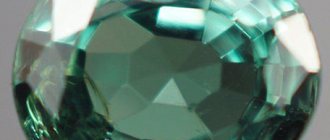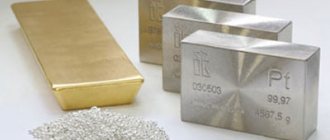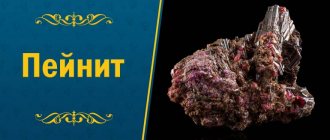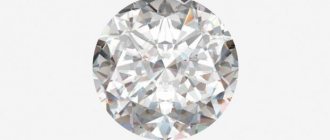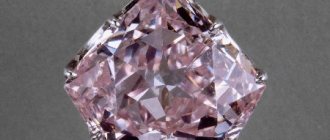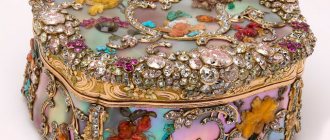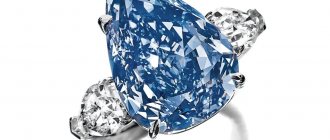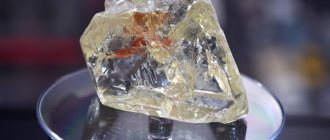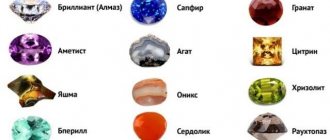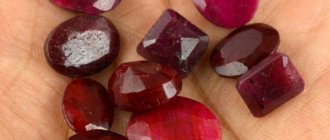Author: Dimon
11 February 2021 13:31
Community: Facts
Tags: jewelry interesting stones
12060
13
Today, about 200 varieties of natural precious stones are known in the world. Along with precious stones (natural diamonds, emeralds, rubies, sapphires and alexandrites, as well as natural pearls in raw (natural) and processed forms) there are many semi-precious stones, some of which are incredibly rare that their value exceeds many of the most valuable gemstones in the world.
0
See all photos in the gallery
Grandidierite
An amazingly beautiful mineral discovered in Madagascar was named after the island explorer Alfred Grandidier. The stones have a pronounced white-green-blue tricolor. The first sample of pure grandidierite was purchased for 29 thousand dollars. Today, the existence of 8 genuine minerals has been confirmed.
0
Magic properties
It is believed that pomegranate can both solve many problems and cause harm. It is always important for women to find a new love or keep an old one. Crystal magic often helps with this.
It has been noticed that ladies with such jewelry often arouse men's interest. The main quality of the stone is to give birth to strong emotions and passions. Even familiar relationships can flare up with renewed vigor. Esotericists believe that the red gem attracts love and supports fidelity.
The “stone of love” is perfect for creative people. Vivid feelings and emotions are important, for example, for actors, musicians, and poets. Decorating with a pomegranate will help you bring back or find inspiration.
The stone has other magical properties:
- This is a talisman used by warriors. The crusaders wore it on campaign to protect against wounds and poisoning. The ancient Mongols drank from pomegranate bowls before battle. Some sorcerers and psychics are confident that the mineral also protects against “invisible arrows.” Black stone is especially good against the evil eye.
- Restores the owner's energy. A person feels more confident in difficult, risky situations: he intuitively finds a way out and decisively brings the matter to the end.
- Green stones are excellent “managers”. A person uses his resources more efficiently and economically: strength, time, money. In this way, the gem helps build a career and unlock potential.
Gifted pomegranates exhibit their magical properties best, while those purchased on their own are worse. Stolen ones cause harm.
Not everyone needs to wear a stone; it is contraindicated for quiet people who are not used to doing a lot. Pomegranate stirs you up and forces you to act. However, you cannot change the essence of a person. Strong emotions and unfulfilled desires cause stress or trouble, and sometimes tragedy.
Majorite
Majorite is named after physicist Alan Major, a unique purple mineral also called purple garnet. Garnets acquire this color when exposed to enormous pressure. It was first discovered in Western Australia. The cost of the 4.2-carat mineral was $6.8 million.
0
Medicinal properties
It is believed that pomegranate is able to restore health:
- Transparent gems improve digestion.
- Brown and yellow stones are used to treat burns and rashes. They also relieve weakness and depression.
- Reds help the heart and cleanse the blood. They also bring hormonal levels back to normal and solve problems with the gastrointestinal tract.
- Greens are used to stimulate blood circulation and for disorders in the lymphatic system. Used for nervous disorders, migraines, memory impairment.
In addition, garnet stone helps:
- cope with various injuries, such as wounds or fractures;
- pregnant women to bear a healthy child;
- for women's and men's diseases;
- for metabolic disorders.
Red diamond (red diamond)
Among colored gems, the rarest is the red diamond, the average price for 1 carat of which reaches 1 million dollars. Natural color is purple-red. This color is given to such diamonds by constant deformations in the structure of the crystal lattice. The most beautiful stones are rated “fancy red.” The only active mine is the Argyle mine in Western Australia. There are about 50 red diamonds in the world.
0
The most expensive and rare gems on the planet
If you still think that the most expensive stones in the world are diamonds, then this video will definitely surprise you. Because there are other, rarer minerals in the world, the price of which often exceeds the cost of diamonds.
The rarity of a stone is an extremely relative concept. For example, a diamond. Previously considered a very rare mineral and gemstone. And now several tens of tons of diamonds are mined every year.
At the same time, there are such incredibly rare stones, including semi-precious stones, that their price exceeds the cost of precious diamonds, sapphires and emeralds.
But first things first. By the way, the video version of this article is presented in this video.
So, below is a selection of the 20 most rare and expensive gems on the planet.
20th place: Eremeevit
20th place in our list of rare and very expensive stones is taken by Eremeevit.
This is a mineral from the borate group - a very rare gemstone. It is aluminum with fluorine molecules attached to it.
The mineral was named after the Russian mineralogist Pavel Eremeev, who first discovered it in 1883 in the southeastern part of the Trans-Baikal region. At first it was mistaken for aquamarine, since the first crystals found were light blue.
By the way, the color of this mineral is not bright and rich. The color of Eremeevite varies from colorless to light blue, yellowish-brown, greenish.
Over the last century, light yellow and even colorless examples have been discovered, but blue ones are still the most expensive on the gem market.
The mineral has a glassy luster and is transparent. Eremeevit hardness is 7-7.5 on the Mohs scale
It is reliably known that at the moment there are several hundred faceted eremeyevites, the cost of which averages $1,500 per carat.
19th place: Blue garnet.
Sometimes it is called blue. The stone was first discovered in Madagascar in the 90s of the 20th century. Today it is found in Tanzania, USA, Sri Lanka, Kenya, Russia. Hardness - 7-7.5 Mohs. It is valued for its exceptional color for garnets and the “Alexandrite effect” - the ability to change its hue when the lighting changes. So in daylight they acquire blue, indigo and green tints, and in artificial light they become purple or red. Today, the average cost of this high-quality gemstone is 1,500 USD. per carat
18th place: Fire opal
In 18th place on our list is fire opal. Fire opals are transparent to translucent stones, mostly with colors ranging from hyacinth red to wine yellow, almost red. Variations with opalescence are mined in Mexico.
The hardness of the stone is the same as that of other opals - 6-6.5 according to Mohs.
The cost of fire opals on the world market today averages $2,300 per carat
17th place: Black opal
Among Noble Opals, black is king. Our black noble opal belongs to the 2nd order precious stones. Australia is the birthplace of excellent quality black opals and is their national stone.
Other rich deposits are Brazil, USA, Mexico. The color of opals of this type can vary from grayish to black with a rich variety of shimmering tints of all colors of the rainbow. Although today these precious stones are no longer considered as rare as they used to be, they are nevertheless quite expensive. The cost of high quality black opal is approximately $2,000 per carat.
16th place: Demantoid.
Demantoid is a green or yellowish-green gemstone from the group of garnets, long known only among collectors. The main deposits of these gems are located in Iran, Pakistan, Russia, Kenya, Namibia and Tanzania. The hardness of the mineral is 6.5 according to Mohs. Excellent quality demantoids are found in the Middle Urals, its second name is “Ural emerald”. The mineral is valued for its appearance: inclusions of bissolite and other minerals may be visible inside - as if golden sparkling threads were placed inside the stone. Every year the popularity of the mineral is steadily increasing, along with which comes an increase in its value. Currently, a top-class carat of demantoid can be purchased on the global gemstone market for an average of $2,000.
15th place: Taffeite
Taffeite is one of the rarest gemstones in the world. The mineral was named after its discoverer, Count Eduard Taffe, who in 1945 accidentally discovered an unusual specimen in a purchased batch of faceted gems that he had never encountered before.
The Mohs hardness of Taffeite is 8.5. The stone has amazing transparency and purity - if you look at it, you will notice two focal refractions. The color of the stone may vary. Depending on its composition, it ranges from lavender to pale pink and lilac. Today, the unique mineral is found in small quantities only in some deposits of Sri Lanka and southern Tanzania. The cost of high-quality taffeite specimens varies from 2 to 5 thousand dollars per carat.
14th place: Poudretteite
Pudrettite is a rare pink mineral first discovered in 1987 in Quebec, Canada. It got its name in honor of the Poudrette family, which still owns the very mine where the first sample was found. Quality stones only began to appear in 2000, when several specimens were found in Myanmar. Since 2005, the mineral has not been discovered there, and the Canadian deposit has given the world only about 300 stones of varying quality.
Pudrettite is of interest to collectors, first of all, for its pleochroism (changes color depending on the direction of the axes): from colorless through light brown to purple-pink. The only negative: the stone is fragile, hardness 5.
Depending on the color saturation and purity, the cost of powderetteite can range from 3 to 5 thousand dollars.
13th place: Musgravit.
Musgravite is a close relative of taffeite, to which it is similar in appearance and chemical composition. It was first discovered in 1967 in Australia's Musgrave Range. Later, the mineral was found in Greenland, Tanzania, Madagascar and even in the depths of the cold lands of Antarctica. This gem comes in several colors, but the most common are green and purple. Due to the fact that very small quantities of these precious stones have been found throughout history, their price reaches quite expected levels: the cost of a carat of high-quality green musgravite is 2-3 thousand dollars, while for one carat of a purple faceted mineral you will have to pay about 6 thousand conventional units.
12th place: Benitoite
Benitoite is a deep blue gemstone whose only deposit is located in San Benito County, California, USA, where it was first discovered back in 1907. In 1984, it was officially designated as the State Gemstone of the state. On the world market, the average cost of small benitoite weighing 1 carat, of which there is an extremely limited quantity in the world (no more than a dozen), is 4000-6000 USD.
11th place: Sapphire
As you know, during their engagement, Prince Charles gave the future Princess Diana a ring decorated not with a diamond, but with a sapphire. The most valuable and high-quality blue sapphires are mined in Kashmir - local stones have a standard cornflower blue color that does not fade even under artificial lighting, and a signature shine that makes you hold your breath to watch the iridescence on the edges.
Less common are pink, green and yellowish-orange gems. And the rarest varieties include blue star sapphire and padparadscha - an orange and red-yellow stone, which we will talk about today.
The largest sapphire is considered to be the Millennium stone, weighing 61.5 thousand carats. On its edges, the artist Alessio Boschi carved 134 portraits of prominent personalities. The stone is currently on sale for $180 million.
The most famous sapphire deposits are located in India, Russia, Vietnam, Thailand, USA, Australia, Myanmar, Sri Lanka, China and Madagascar. Today, high-quality specimens of sapphires on the world market can be purchased for approximately 4-6 thousand dollars per carat.
10th place: Emerald
Tenth place on our list is occupied by emerald - a very rare and expensive gemstone of the first order. Sometimes it is also called the second precious stone after the diamond.
The gem is a subspecies of beryl.
The most expensive emerald is the two-kilogram Fura stone, found in Colombia. It was valued at $150 million. Another record holder among emeralds is the Teodora gem, recovered from a mine in Brazil. It weighs five times more than the Fura emerald (11.5 kilograms), but experts valued it at only $1.5 million.
The Theodora is the fifth largest emerald ever mined and the largest ever cut. Before treatment he weighed 28 kilograms.
But, of course, not all emeralds are so expensive. Today, the price of emeralds on the world market averages from 2 to 25 thousand dollars per carat
9th place: Painite
Painite was first discovered by British mineralogist Arthur Charles Payne in 1951 and was recognized as a new mineral in 1957. For many years, only one example of the dark red crystal existed, which was kept in the British Museum in London, making it the rarest in the world a precious stone. Later, two more such stones were discovered. This went on for many decades. Until two more crystals were found in 2005. Thus, according to official statistics, a total of only 25 painite crystals have been found in the world today, which has made this stone truly priceless.
However, some sources say that in 2006 another deposit was discovered in Myanmar, where more than 1,000 stones have already been mined, but they are of lower quality.
8th place: Bixbit or red beryl
Bisxbite, also known as red beryl or red emerald, is such a rare stone that the Utah Geological Survey says only one is mined for every 150,000 gem-quality diamonds. Pure beryl is colorless and acquires its shades only from impurities: chromium and vanadium give beryl a green color, forming an emerald; iron adds a blue or yellow tint, creating aquamarine and golden beryl, and manganese adds a deep red color, creating red beryl.
Red beryl is found only in the US states of Utah, New Mexico, and Mexico, but most of the stones found are only a few millimeters in length (that is, too small to be cut and faceted).
It is extremely difficult to purchase high-quality red beryl, and the price for a stone weighing about 1 carat is more than 10-12 thousand US dollars. Determining the average cost of this mineral is quite difficult due to the small number of high-quality stones offered for sale.
7th place: Alexandrite
Alexandrite is a famous gemstone famous for its ability to change color. In daylight, its color is characterized by bluish-green, dark blue-green and olive green, while in artificial light its iridescence can take on pink-crimson, red, purple or violet-red. The first crystal was discovered in 1833 at an emerald mine in the vicinity of Yekaterinburg. The cost of this gemstone, depending on its quality, can range from 10 to 15 thousand dollars.
6th place: Paraiba Tourmaline
In sixth place on our list of the rarest and most expensive stones in the world is a beautiful and very rare crystal of bright blue-turquoise color, discovered in 1987 in the state of Paraiba, in eastern Brazil.
For a long time, this gemstone was mined in only one place, but today there are already deposits of it in Madagascar and Mozambique. The hardness of Paraiba tourmaline is 7.5 Mohs. The mineral has a unique shade of neon blue; its “glow” is the main factor that increases the value of the stone tenfold.
Brazilian blue tourmalines today cost between 12-15 thousand dollars per carat, and a truly unique gem of the highest quality can far exceed these figures.
5th place: Ruby
Ruby is a type of corundum mineral, one of the most valuable gems born in the depths of our planet. Ruby color can vary from brown to pink; It is this factor that primarily determines the final price of the found gem. Jewelers also pay attention to the number of foreign inclusions - the fewer, the better.
And the rarest and most expensive rubies have a rare shade - the so-called “pigeon blood color”. Such rubies are mined from deposits in Myanmar and Sri Lanka. The cost of high-quality natural rubies on the world market ranges from 15 to 18 thousand dollars per carat.
4th place: Jadeite (imperial)
Jadeite (imperial) is a green mineral that has long held the status of one of the most mysterious stones on our planet. Today, its main sources are in China, Upper Myanmar, Japan, Mexico, Kazakhstan, Guatemala and the USA. The approximate cost of a carat of high quality jadeite on the world market is 20 thousand dollars.
3rd place: Padparadscha Sapphire
Padparadscha sapphire (meaning "sunrise color" in Tamil) is a pinkish-orange sapphire that was historically mined in Sri Lanka, Tanzania and Madakascar.
Now in Sri Lanka there is practically no padparadscha left in its natural form, so the rare color of the mineral is obtained by heating corundum in a furnace to the desired condition. The last classic (that is, unheated) padparadscha weighing 1.65 carats was sold in Sri Lanka about 20 years ago for $18,000. Now padparadscha weighing over five carats is considered collectible and can be valued at up to 30 thousand dollars for each carat of weight. If the color of the sapphire has not been refined, the difference with the refined sample is tens of thousands of dollars.
2nd place: Grandidierite
Grandidierite is a rare mineral of greenish-blue, greenish-blue or bluish-green color. The first sample of the mineral was discovered in Sri Lanka. At the beginning of the twentieth century, it was described by the French explorer Alfred Grandidier, who was engaged in the study of Madagascar, on the territory of which the bulk of these minerals are still mined today. Faceted grandidierites exist today in extremely limited quantities. There are about two dozen such stones in the world. The approximate cost of the unique mineral is more than 30 thousand dollars per carat.
1st place: Red Diamond
Diamond is still one of the most expensive and desirable gemstones. The reason for this, of course, is the enormous popularity of cut diamonds, known to everyone as diamonds.
The most expensive and rare among diamonds are colored minerals, among which the red diamond stands out as the most expensive representative of its family and, at the same time, the most expensive gemstone in the world. In the entire history of mankind, only a few specimens of this mineral have been found and most of them have a very small weight - less than 0.5 carats. The color of a natural red diamond is called purple-red by gemologists. The only deposit of colored diamonds is located in the Argyle diamond mine in Australia, from which only a few stones are mined annually. Gemstones weighing more than 0.1 carats typically only appear at auctions where the price per carat is more than one million dollars.
For comparison, the cost of ordinary cut D-color diamonds today averages about 15,000 thousand dollars per carat.
So, these were the top 20 rarest and most expensive stones in the world. Write in the comments which stones you like best. And we will talk about them in the following publications.
Red beryl
"Red beryl" or "red emerald" was first described in 1904 by the American mineralogist Bixby. Chemical analysis shows a connection with aquamarine and emerald, but red beryl is a very rare mineral. There are active deposits only in the USA. The extraction process is technologically very complex. The largest faceted mineral weighs no more than 10 carats.
0
Taaffeit
Taaffeite is a rare mineral of the oxide class. Opened in 1945 by Earl Richard Taaffe in Dublin. In the batch of precious stones, he noticed one that was significantly different from the others. It was initially mistaken for an unusual spinel.
A detailed analysis of the stone by members of the mineralogical department of the British Museum showed that the sample belongs to a previously unknown mineral. Using X-rays and chemical analysis, it was determined that the stone's composition was intermediate between spinel and chrysoberyl.
Taaffeite has a hardness of 8 out of 10 on the Mohs scale. This means that it can only be scratched by harder stones - corundum (score 9) and diamond (score 10). The color of the stone varies from colorless and greenish to pinkish.
Alexandrite
An amazing stone that can change its color was discovered in 1830 in the Urals in Russia and named after the Russian Tsar Alexander II. Alexandrite is a variety of chrysoberyl and appears blue-green in sunlight, but turns red-violet in incandescent light. The cost of this gem weighing up to 1 carat is $15,000, but a stone weighing more than one carat will cost $70,000 per carat.
0
Tanzanite
Tanzanite is a rare mineral that was discovered in 1966 in the area of Mount Kilimanjaro. It got its name because it is mined only in Tanzania. Initially, tanzanite was mistaken for an ordinary sapphire, but already the following year it became clear that this was a special mineral.
Although tanzanite is a very rare stone, mined only in one deposit, it has acquired value not only for its rarity. The popularity of tanzanite was facilitated by a successful advertising campaign that promoted the unique color of the stone. The campaign attracted celebrities, including Hollywood film star Elizabeth Taylor.
The main colors of tanzanite are shades of blue and violet. Each stone is graded on a complex color scale. Tanzanite is an impeccable stone because it is pure, and even a person with perfect eyesight will not be able to see inclusions in it. The cost of tanzanite can reach several thousand dollars per carat.
Hiddenite or lithium emerald
For those who want to stand out with the originality of their jewelry, giddenite is suitable. It is also called lithium emerald. These precious and rare crystals are of very poor quality and are completely unsuitable for processing, although you can find specimens that make good jewelry. A rare stone can be used as a talisman.
It is believed to attract good luck and material well-being, which is why it is very popular among businessmen. But he helps only purposeful people and does not tolerate lazy people and dreamers.
Giddenite can be used not only by businessmen, but also by creative people, but only if they persistently achieve their goal.
It also has medicinal properties. Giddenite has a beneficial effect on the cardiovascular system and enhances the effect of drugs. But to do this, it must be worn as a bracelet or ring on the little finger.
Important: How to clean jewelry at home.
Imperial jadeite
Imperial jadeite, or imperial, is a stone very rarely found in Russia. Regular jadeite can have several colors - lilac, red, purple, pink or orange. However, imperial jadeite can be exclusively light green in color. It is mined in the countries of Southeast Asia - Japan, China, Thailand, Burma, Taiwan. Moreover, it is found not in the form of individual crystals, but in veins extending to the surface. The structure of the mineral allows only one type of cut to be used for its processing - cabochon; it is not cut, but only sawed and polished. You can only saw it with diamond tools, it is too hard. A high-quality specimen the size of an adult's fingernail costs millions of dollars. The name jadeite comes from the Spanish word jada - kidneys, or piedra de la jada - stone for the treatment of kidneys. In the Middle Ages, people believed in the ability of the mineral to relieve renal colic and other diseases of these organs. In ancient China, jadeite was elevated to the level of a divine stone, it was used to make religious objects, and they decorated temples and homes of the nobility with it. Since green jadeite was very rare, all found specimens were delivered to the imperial court, for which the stone received its second name - imperial. Sometimes colored jadeite, which originally had a creamy white hue, is sold in Asia under the guise of imperial. Such samples themselves are very cheap, and in order to increase their price, enterprising craftsmen have learned to coat them with green powder paint. It is very difficult to distinguish a fake from a natural stone; this can only be done in special laboratories using expensive equipment.
Bixbit
Bixbite is a red beryl. The color of the stone can be not only red, but also deep pink, with a gooseberry tint, which depends on the content of lithium and cesium. Bixbite is mined in North American deposits in the states of Utah and New Mexico. Bixbit is rarely used for making jewelry; mostly, found specimens are dispersed into private collections. 1 carat of bixbite costs more than 12 thousand dollars, although this amount may be inaccurate due to too few large specimens. The name of the stone was given in honor of the mineralogist Bixby, who was the first to find and describe it.
How to wear the mineral
Lithotherapists say that you should not wear the gem all the time. It symbolizes emotions and strong passions, which can sometimes be tiring. If you wear a pomegranate, especially a green one, for more than one phase of the moon, it begins to harm:
- evokes too many emotions;
- makes you waste your energy;
- makes a person overly picky and capricious in any matter.
When wearing you need to consider:
- Garnets do not go well with malachites and onyxes. Their combined effect on humans is considered unfavorable.
- Gold and silver jewelry with garnet inserts should not be worn at the same time.
- Some stones match your eye color, such as green demantoid stones.
- Earrings are sometimes complemented by a ring or pendant of the same color. Beads can be contrasting.
- Simple necklaces are made from small, cloudy stones of different sizes. The most expensive ones are the large, transparent ones. They are cut by hand because it pays off. There are intermediate options.
- To cope with nervous disorders or migraines, wear a garnet ring on the middle finger of the right hand.
Product care
The gem is durable and unpretentious. However, it is advisable to properly care for pomegranate:
- Wash in water at room temperature. You can add a little soap. A soft brush or cloth will do. If the water is too hot or cold, cracks may appear on the surface over time.
- After washing, rinse the jewelry and wipe with a soft cloth.
- It is important to avoid contact with detergents, cosmetics, and chemicals. For example, during dirty work, it is advisable to remove products in the shower.
- The crystal is hard, but it is better to protect it from mechanical damage.
- Do not remove the garnet from the frame for cleaning. The fastenings can become loose, and the stones can then get lost.
- It is advisable to store gems wrapped in soft cloth in a special box, separately from other jewelry. This will help avoid scratches.
- Sometimes they cleanse from bad or simply alien energy. This must be done if the stone was worn by another person. The easiest way is to keep it in water.
The garnet looks great and effectively protects the owner, but it is better for calm, thoughtful people not to wear it all the time. The gem is a talisman of energetic, enthusiastic and life-loving people.
